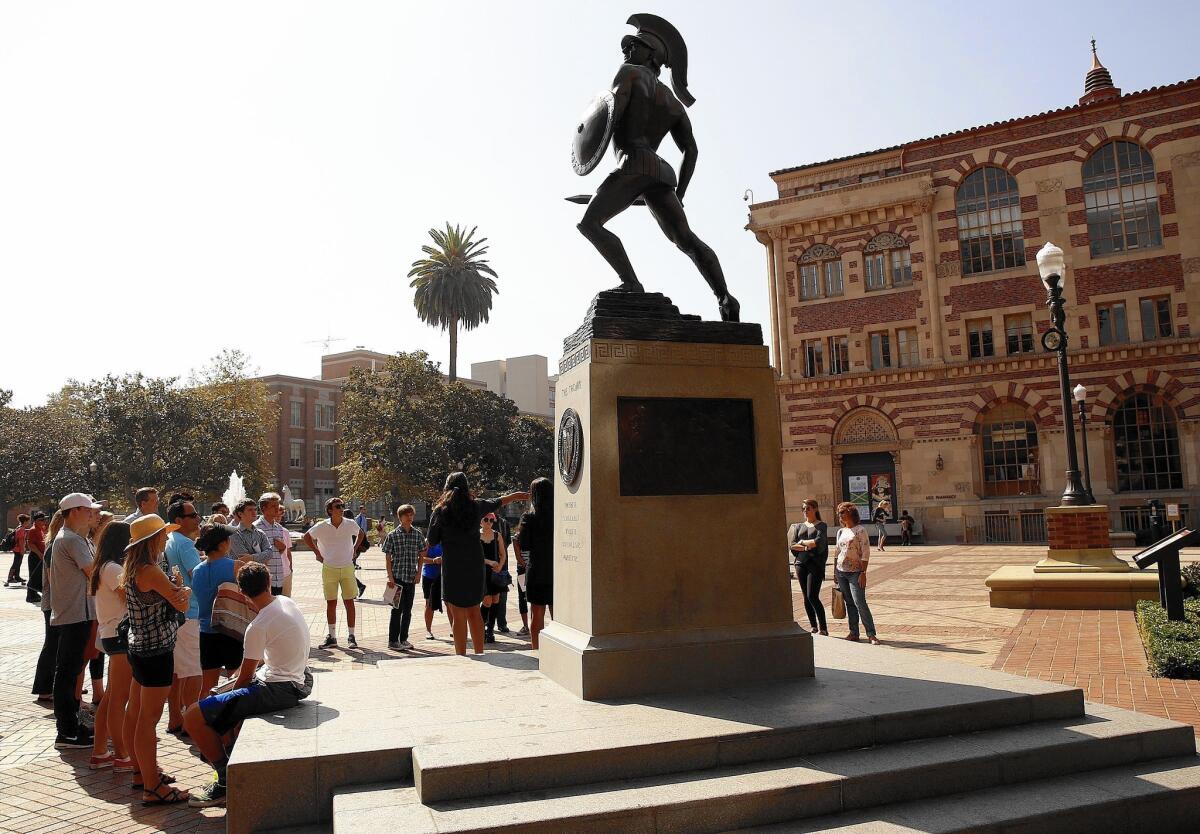Opinion: USC has been rocked by admissions and sexual assault scandals. Money could be its next crisis

- Share via
Carol L. Folt’s inauguration as president of USC on Friday is less a celebration and more a sigh of relief for a scandal-weary university. First came revelations about a medical-school dean’s drug use and criminal behavior, followed by allegations of sexual assault at the student health center, of pay-to-play shenanigans at the school of social work and of bribery in admissions.
Folt, hired from the University of North Carolina, started July 1 and has been busy cleaning house. The provost and athletic director are gone; a new vice president for student affairs has started; the vice president for research is out the door on Jan. 1; and the football coach is on thin ice.
No one, especially Folt, needs more problems, but a new crisis is hitting USC, created by the university’s fiscal structure, the actions of the previous administration and a contested political environment. This one is about money.
USC’s fiscal model is called Responsibility Centered Management, or RCM, and it’s often defined by the phrase “Every tub on its own bottom.” RCM lets revenue-generating “units” — colleges, schools and departments at USC — keep a majority of the revenue they generate; they are also responsible for their own costs.
If a school has 1,000 students, it gets the tuition revenue; if it increases its student body, it gets more revenue. Bigger is better. If research from faculty generates $5 million, and the unit uses some of those gains to hire academic stars who generate $10 million more, the unit wins.
Responsibility Centered Management is a model borrowed from business and other aggressively “entrepreneurial” colleges and universities. It has enabled USC to compete, providing resources to build buildings, develop labs and hire new faculty. The university’s rise in higher-ed rankings can, in part, be attributed to RCM. But it has also contributed mightily to USC’s problems.
A radically decentralized fiscal system lacks oversight, and it makes everyone’s prime goal a constant search for more money. It might, say, lead administrators to forgive the problems of a doctor at the medical school because he is a good fundraiser, or push deans to lower admission standards to increase tuition revenue.
Besides the creation of troubling incentives, the revenue streams RCM encourages have limits. For example, some schools at USC, in part to increase student tuition dollars, have brought in thousands of full-paying international students, especially from China and India. China and India, however, are investing in higher education, so their students will feel less need to study abroad. The Trump administration’s unrelenting condemnation of immigrants also has made foreign students feel unwelcome. The result is likely to be the elimination of revenue from thousands of students whom USC previously viewed as easy money.
USC has also tried to generate tuition dollars through online learning. Among the school of social work’s problems was just such a program that at first was characterized as a “cash cow” but, over the long term, didn’t pay for itself. It wasn’t good for the students either. Many paid full-fee tuition and ended up with debt that couldn’t be paid off on social work salaries. Independent researchers have questioned the quality of online education as well. One way or another, fixing the problems associated with online education will surely result in lost revenue for the university.
A success story for USC has been its capital campaigns. From 1991 to 2010, with President Steven B. Sample, and then with President C.L. Max Nikias, USC had among the most successful fundraising efforts of any university in the nation. Nikias, who was forced to resign in 2018 as scandals mounted, oversaw a capital campaign that reportedly brought in more than $7 billion.
But the hits to USC’s reputation over the last few years have surely cast a pall on philanthropic giving, the lifeblood of a private research university. This can’t help but spell trouble for the Folt administration. Neither she nor her new provost, from the University of Buffalo, have a history of fundraising on USC’s scale, and their public university experience will meet private university expectations.
In 1992, Stanford University faced similarly difficult times. The 1989 Loma Prieta earthquake had caused expensive damage to the campus, a recession was reducing revenue, and the university’s use of federal grant money was under investigation. The board and faculty banded together to encourage Stanford President Donald Kennedy to resign. A new president, Gerhard Casper, and provost, Condoleezza Rice (appointed from within Stanford), began anew, with a reconfigured capital campaign. It generated more than $2 billion, a big number at the time.
The challenges facing the fractured USC board of trustees, the new administration and a restive faculty are serious. Teamwork is essential, as is transparency. As an initial step of good faith, the board and the administration should release all the accumulated confidential reports about the scandals.
At the least, RCM needs to be reformed and probably dismantled. It will be the faculty’s job to develop a new strategic plan that concisely sets a new course. The board needs to swiftly review the plan and launch a reconfigured capital campaign with clearly stated rules and enforcement mechanisms related to the parameters of donations.
USC’s upward trajectory has been spectacular. It has made admirable progress in the recruitment and graduation of first-generation students and students of color. The faculty and students can compete with their peers on any global campus. Now Folt, the board and the faculty have their work cut out for them: Build on the best of what defines USC .
William G. Tierney is a fellow at the European University Institute in Florence, Italy, and a university professor and founding director of the Pullias Center for Higher Education at USC.
More to Read
A cure for the common opinion
Get thought-provoking perspectives with our weekly newsletter.
You may occasionally receive promotional content from the Los Angeles Times.










